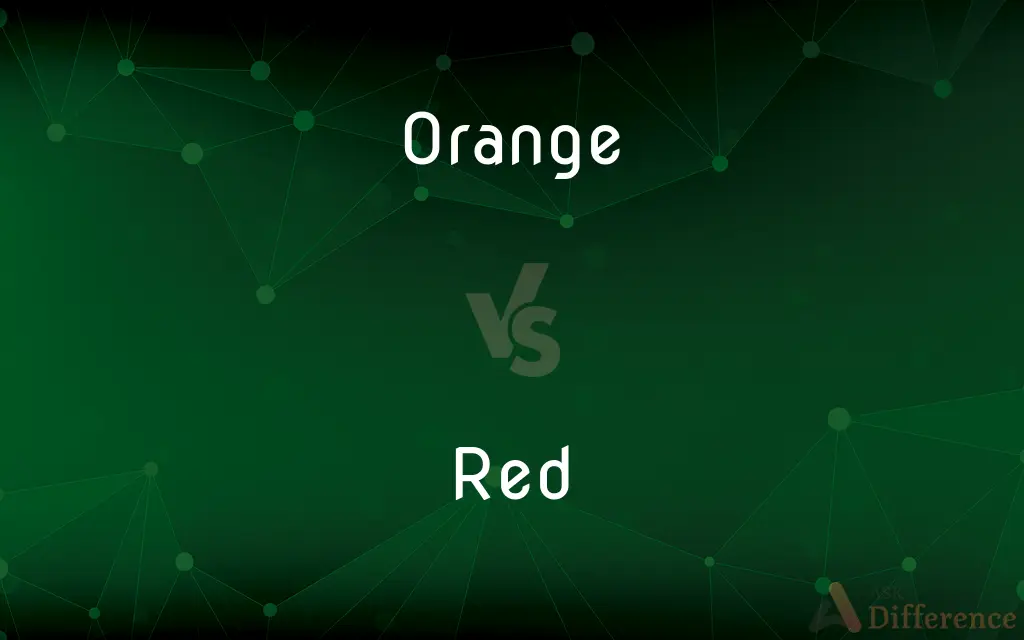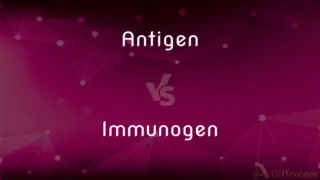Orange vs. Red — What's the Difference?
Edited by Tayyaba Rehman — By Urooj Arif — Updated on April 5, 2024
Orange radiates warmth and joy, associated with creativity and the sunset, while red evokes passion, danger, and strength.

Difference Between Orange and Red
Table of Contents
ADVERTISEMENT
Key Differences
Orange, a blend of red and yellow, symbolizes warmth, creativity, and enthusiasm. It's often associated with the joy of sunsets and autumn leaves, conveying a sense of freshness and vitality. Whereas red, a primary color, stands for passion, energy, and danger. It has a bold presence, influencing emotions deeply and is commonly used in warnings and to signify love.
Orange, in cultural contexts, can represent happiness and spiritual enlightenment, seen in marigolds in Indian festivities and Buddhist monks' robes. On the other hand, red holds significant cultural symbolism, representing good fortune in China, mourning in South Africa, and political ideologies worldwide, highlighting its diverse interpretations.
In marketing and branding, orange is used to stimulate appetite, promote social communication, and encourage impulsive buying. It's seen in brands that want to appear friendly and accessible. Meanwhile, red grabs attention, creates urgency, often used in clearance sales, and is favored by brands that wish to evoke strong emotions or suggest speed.
In nature, orange colors are found in sunsets, fall leaves, and citrus fruits, evoking a sense of change, growth, and vitality. Red, however, is seen in roses, and fire, symbolizing life, love, and danger, reflecting its powerful essence in natural settings.
Regarding color psychology, orange is perceived as inviting and stimulating, promoting conversations and comfort. It's less aggressive than red, offering a softer, more nurturing energy. Red, conversely, is stimulating in a more intense manner, associated with increased heart rate and urgency, indicating its more provocative and dynamic nature.
ADVERTISEMENT
Comparison Chart
Symbolism
Creativity, enthusiasm, warmth
Passion, danger, energy
Cultural Significance
Happiness, spirituality in Indian and Buddhist traditions
Good fortune in China, mourning in South Africa, political power
Marketing Use
Appetite stimulation, friendliness, impulsive buying
Attention-grabbing, urgency, love, speed
Psychological Effect
Stimulating yet nurturing, promotes comfort and conversation
Increases heart rate, evokes urgency and strong emotions
Compare with Definitions
Orange
Used in safety equipment.
Workers wear orange vests for high visibility.
Red
Used in signs of warning.
The document was marked with a red confidential stamp.
Orange
A color blending red and yellow.
The sunset was a beautiful shade of orange.
Red
Represents political ideologies.
The red banner represented the party's values.
Orange
Sign of spirituality in some cultures.
Buddhist monks wear orange robes.
Red
A primary color at the end of the visible spectrum.
The red flag stood out against the blue sky.
Orange
Represents autumn and harvest.
Orange leaves signify the beginning of fall.
Red
Indicates urgency or sale in marketing.
The store displayed a big red sale sign.
Orange
Symbolizing creativity and change.
The orange branding suggests innovation.
Red
Symbol of passion and danger.
Red roses are a classic symbol of love.
Orange
A town in southern France, on the River Rhône, home of the ancestors of the Dutch royal house.
Red
Red is the color at the long wavelength end of the visible spectrum of light, next to orange and opposite violet. It has a dominant wavelength of approximately 625–740 nanometres.
Orange
Relating to the Orange Order
Orange marches
Red
A pigment or dye having a red hue.
Orange
Any of several evergreen trees of the genus Citrus of Southeast Asia, widely cultivated in warm regions and having fragrant white flowers and round fruit with a yellowish or reddish rind and a sectioned, pulpy interior, especially the sweet orange and the bitter orange.
Red
Something that has a red hue.
Orange
The fruit of any of these trees, having a sweetish, acidic juice.
Red
Often Red A Communist.
Orange
Any of several similar plants, such as the Osage orange and the mock orange.
Red
A revolutionary activist.
Orange
The hue of that portion of the visible spectrum lying between red and yellow, evoked in the human observer by radiant energy with wavelengths of approximately 590 to 630 nanometers; any of a group of colors between red and yellow in hue, of medium lightness and moderate saturation.
Red
The condition of being in debt or operating at a loss
The firm has been in the red all year.
Orange
Of the color orange.
Red
Reddish in color or having parts that are reddish in color
A red dog.
A red oak.
Orange
Made from oranges.
Red
Having a reddish or coppery skin color.
Orange
Tasting or smelling like oranges.
Red
Often Red Often Offensive Of or being a Native American.
Orange
(countable) An evergreen tree of the genus Citrus such as Citrus sinensis.
Red
Having a ruddy or flushed complexion
Red with embarrassment.
Orange
(countable) The fruit of the orange tree; a citrus fruit with a slightly sour flavour.
Red
Relating to or being a red state.
Orange
The colour of a ripe fruit of an orange tree, midway between red and yellow.
Red
Often Red Communist.
Orange
Various drinks:
Red
Having red#Noun as its color.
The girl wore a red skirt.
Orange
(uncountable) Orange juice.
Red
(of hair) Having an orange-brown or orange-blond colour; ginger.
Her hair had red highlights.
Orange
(uncountable) An orange-coloured and orange-flavoured cordial.
Red
(of the skin) With a red hue due to embarrassment or sunburn.
Orange
(uncountable) An orange-coloured and orange-flavoured soft drink.
Red
Of the hearts or diamonds suits. Compare of the spades or clubs suits
I got two red queens, and he got one of the black queens.
Orange
Having the colour of the fruit of an orange tree; yellowred; reddish-yellow.
Red
Supportive of, related to, or dominated by a political party or movement represented by the color red:
Orange
(transitive) To color orange.
Red
Left-wing parties and movements, chiefly socialist or communist, including the U.K. Labour party and the Social Democratic Party of Germany.
The red-black grand coalition in Germany
Orange
(intransitive) To become orange.
Red
(US politics) The U.S. Republican Party.
A red state
A red Congress
Orange
The fruit of a tree of the genus Citrus (Citrus Aurantium). It is usually round, and consists of pulpy carpels, commonly ten in number, inclosed in a leathery rind, which is easily separable, and is reddish yellow when ripe.
Red
Amerind; relating to Amerindians or First Nations
Orange
The tree that bears oranges; the orange tree.
Red
(astronomy) Of the lower-frequency region of the (typically visible) part of the electromagnetic spectrum which is relevant in the specific observation.
Orange
The color of an orange; reddish yellow.
Red
(particle physics) Having a color charge of red.
Orange
Of or pertaining to an orange; of the color of an orange; reddish yellow; as, an orange ribbon.
Red
(countable) A revolutionary socialist or (most commonly) a Communist; usually capitalized a Bolshevik, a supporter of the Bolsheviks in the Russian Civil War.
Orange
Round yellow to orange fruit of any of several citrus trees
Red
One of the 15 red balls used in snooker, distinguished from the colours.
Orange
Any of a range of colors between red and yellow
Red
Red wine.
Orange
Any citrus tree bearing oranges
Red
(countable) Any of several varieties of ale which are brewed with red or kilned malt, giving the beer a red colour.
Orange
Any pigment producing the orange color
Red
A red kangaroo.
Orange
A river in South Africa that flows generally westward to the Atlantic Ocean
Red
A redshank.
Orange
Similar to the color of a ripe orange
Red
An American Indian.
Red
(slang) The drug secobarbital; a capsule of this drug.
Red
(informal) A red light a traffic signal
Red
(particle physics) One of the three color charges for quarks.
Red
Usually in the phrase "bowl of red".
Red
(informal) The redfish or red drum, Sciaenops ocellatus, a fish with reddish fins and scales.
Red
Tomato ketchup.
Red
(archaic) rede
Red
To put on order; to make tidy; also, to free from entanglement or embarrassement; - generally with up; as, to red up a house.
Red
A red pigment.
Red
The menses.
Red
A tributary of the Mississippi River that flows eastward from Texas along the southern boundary of Oklahoma and through Louisiana
Red
Emotionally charged terms used to refer to extreme radicals or revolutionaries
Red
The amount by which the cost of a business exceeds its revenue;
The company operated at a loss last year
The company operated in the red last year
Common Curiosities
What does red symbolize in nature?
Red symbolizes life, love, and danger in nature.
How do orange and red differ in marketing?
Orange is used to stimulate appetite and suggest friendliness, whereas red creates urgency and evokes strong emotions.
What is the cultural significance of red in China?
In China, red symbolizes good fortune and happiness.
What emotions does orange evoke?
Orange evokes warmth, enthusiasm, and creativity.
Can the color orange stimulate appetite?
Yes, orange can stimulate appetite and promote impulsive buying.
How does red influence emotions?
Red influences emotions by evoking passion, danger, and urgency.
Is orange considered a warm or cool color?
Orange is considered a warm color.
Why do Buddhist monks wear orange?
Buddhist monks wear orange to symbolize simplicity and detachment from materialism.
What does orange represent in autumn?
Orange represents change, growth, and the vibrancy of autumn leaves.
Why is red associated with love?
Red is associated with love due to its intensity and passion.
What does the color orange signify in branding?
In branding, orange signifies friendliness, creativity, and encouragement of social communication.
What makes orange a good color for safety equipment?
Orange is highly visible, making it suitable for safety equipment to ensure high visibility.
What psychological effects does red have?
Red increases heart rate and evokes feelings of urgency and passion.
Why is red used in warning signs?
Red is used in warning signs because it grabs attention and signifies danger.
How is red used in politics?
Red is often used to represent political power and ideologies.
Share Your Discovery

Previous Comparison
Antigen vs. Immunogen
Next Comparison
Wool vs. LanaAuthor Spotlight
Written by
Urooj ArifUrooj is a skilled content writer at Ask Difference, known for her exceptional ability to simplify complex topics into engaging and informative content. With a passion for research and a flair for clear, concise writing, she consistently delivers articles that resonate with our diverse audience.
Edited by
Tayyaba RehmanTayyaba Rehman is a distinguished writer, currently serving as a primary contributor to askdifference.com. As a researcher in semantics and etymology, Tayyaba's passion for the complexity of languages and their distinctions has found a perfect home on the platform. Tayyaba delves into the intricacies of language, distinguishing between commonly confused words and phrases, thereby providing clarity for readers worldwide.














































